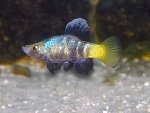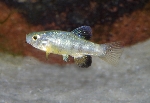
Behavioral diversification in a young species flock of pupfish (Cyprinodon spp.): shoaling and aggressive behavior
By Strecker, Ulrike, M. Plath
Behavioral Ecology and Sociobiology, 2007. DOI: 10.1007/s00265-008-0601-9
" Increasing empirical and theoretical evidence supports the idea that sympatric speciation is operating, for example, in species flocks comprising several closely related fish species within one lake. Divergent natural selection (promoting spatial and food niche partitioning) and sexual selection (assortative mating) have been identified as key selection factors in intralacustric adaptive radiations. However, the evolution of social behaviors accompanying such adaptive radiations is less well understood. Using a phylogenetically young species flock of pupfish (Cyprinodon spp.) as a model, we examined differences among six sympatric species and compared their shoaling, aggressive, and territorial behaviors with that of a sister species (C. artifrons). Despite an estimated age of the species flock of less than 8,000 years, pronounced behavioral differentiation was found. C. simus, the smallest species in the flock, shoaled more than the other species and was less aggressive and less territorial than C. beltrani. F1-hybrids between C. simus males and C. beltrani females showed an intermediate expression of shoaling and aggressive behavior. Niche partitioning among the members of this species flock appears to be accompanied by rapid divergent evolution of social behaviors. We discuss the potential role of phenotypic plasticity and within-species variation of social behaviors for such rapid behavioral diversification in sympatric speciation processes "
Language: English
Reference in bibliography for species (6)
Strecker, Ulrike & M. Plath. 2007. "Behavioral diversification in a young species flock of pupfish (Cyprinodon spp.): shoaling and aggressive behavior". Behavioral Ecology and Sociobiology. DOI: 10.1007/s00265-008-0601-9 (ffm00587) (abstract)





